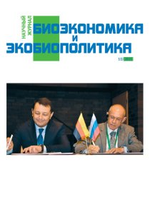Hydroxylation of Steroids by Filamentous Fungi as a Platform for Production of High-Valued Pharmaceutical Intermediates
Авторы: Коллеров В. В., Фокина В. В., Шутов А. А., Суходольская Г. В., Лобастова Т. Г., Донова М. В.
Рубрика: Тезисы
Опубликовано в Биоэкономика и экобиополитика №1 (1) декабрь 2015 г.
Дата публикации: 15.01.2016
Статья просмотрена: 50 раз
Библиографическое описание:
Hydroxylation of Steroids by Filamentous Fungi as a Platform for Production of High-Valued Pharmaceutical Intermediates / В. В. Коллеров, В. В. Фокина, А. А. Шутов [и др.]. — Текст : непосредственный // Биоэкономика и экобиополитика. — 2015. — № 1 (1). — URL: https://moluch.ru/th/7/archive/20/646/ (дата обращения: 25.04.2025).
Hydroxylation is one of the most important reactions of steroid functionalization. Steroids of pregnane or androstane series with hydroxyl functions at positions 11α/β or 14α are widely used as anti-inflammatory, immunosuppressive, anabolic and contraceptive agents; 7α/β-hydroxyderivatives of bile acids are known for their therapeutic action against many human diseases.
Microbial catalysis is an effective tool for steroid hydroxylation which allows generation of the compounds which may be difficult to obtain by conventional synthetic methods. Hydroxylase activity towards steroids is widespread among the fungi. However, practical realization of steroid hydroxylation bioprocesses by fungi is often restricted by insufficient selectivity because of some side reactions in whole-cell catalysis. In this regard the search of new highly efficient biocatalysts capable of selective steroid hydroxylation is of importance.
In this work we used experimental screening in order to reveal novel strain candidates with target steroid hydroxylase activity. More than 300 fungal strains of different taxonomy were tested on their capability to catalyze regio- and stereospecific hydroxylation of 3-keto- and 3α/β-hydroxy-steroids of adrostane, pregnane and cholane series with optimization of processes by the most active strains.
The representatives of Gongronella, Scopulariopsis, Epicoccum, and Curvularia genera have been revealed as the most promising biocatalysts for steroid 11β-hydroxylation of cortexolone, deoxycorticosterone and their acetylated derivatives. The presence of 17-acetyl group was shown to facilitate further selectivity of 11β-hydroxylation. The strains of C. lunata VKM F-644 and G. butleri VKM F-1033 expressed maximal target activity. Original procedures for protoplasts obtaining, mutagenesis and mutant strain selection of C. lunata allowed obtaining of a stable mutant M4 with increased 11β-hydroxylase activity that provided over 90% of 11β-hydroxylated derivatives under optimized conditions. C. lunata M4 mutant strain was also revealed as the most effective biocatalyst of 14α-hydroxylation towards steroids of androstane series. The maximal yield of 14α-OH derivative (up to 80%) was obtained at the incubation of C. lunata M4 strain with 9α-hydroxyandrostendione. Another strain, - Aspergillus ochraceus was shown to be the most effective biocatalyst for 11α-hydroxylation of androstendione (AD); yield of 11α-OH-AD exceeded 95%.
The capability of pregnenolone transformation to 11α-hydroxyprogesterone with 3β-ОН group oxidation, ∆5→∆4-izomerization and 11α-hydroxylation combination in one biotechnological stage was revealed for
Rhizopus stolonifer VKM F-401, as well as for three strains of Aspergillus genus with its maximal level in Aspergillus niger VKM F-212. 11α-Hydroxyprogesterone was accumulated as major product yielding up to 70% under the optimized conditions.
With the exception of few experimental works, lithocholic (LCA) and deoxycholic (DCA) acids have not been strongly investigated as a substrates for bioconversion by fungi. We firstly revealed the formation of 7α/β-hydroxylated derivatives for 34 tested fungal strains of different taxonomy. Under the optimized conditions, the yield of 7β-OH-derivatives: ursodeoxycholic (UDCA) and ursocholic (UCA) acids reached 90% during LCA and DCA transformation by Gibberella zeae VKM F-2600 and Fusarium merismoides VKM F-2310 strains, correspondingly.
The results confirm that experimental screening is still a powerful tool for the discovery of novel active biocatalysts. Fungal strains are capable of effective regio- and stereoselective hydroxylating of different types of natural and synthetic steroid substrates of both pregnane and androstane series, as well as bile acids. The results might be suitable for preparative-scale exploitation of the selected fungal strains for production of highvalued hydroxylated intermediates for pharmaceutical industry.







